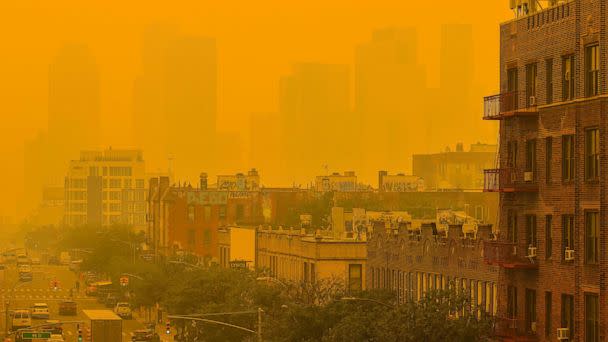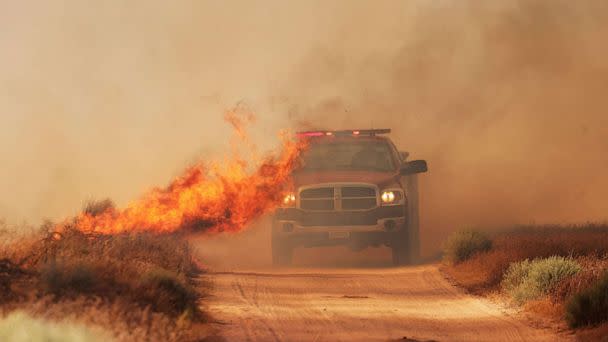What East Coasters could learn from West Coast wildfires as smoke from Canada hits Northeast

While the Northeast may be unfamiliar with hazy conditions caused by smoke from wildfires, which blew down from Canada, the West Coast is far more familiar.
On the West Coast, wildfires are common, but over the past few years, they have become larger and more widespread, causing more damage.
With Canada currently on track to potentially experience its worst wildlife season ever, meaning New York City and other areas, could see more smoky conditions over the next few months, there may be lessons to learn from how the West Coast handles large blazes.
MORE: What parents should know about kids' safety and exposure to dangerous levels of wildfire smoke
"I grew up in upstate New York, so I have relatives there, actually talked to a couple of them," Dr. Michael Coughlan, an environmental anthropologist at the University of Oregon who studies wildfires and fire management, told ABC News. "And one of the comments that one of them had was that, 'Oh, well, you know, this has never happened before so it's not gonna happen again.' And I thought that was an interesting comment."
He continued, "I do think there's really a connection between the experience that people have and their preparedness, and their sort of acceptance of this being an issue."

Reducing wildfire fuels
In the western United States, teams start preparing for wildfire season by removing small trees and shrubs that may fuel fire, Dr. Maureen Kennedy, an assistant professor at University of Washington Tacoma who studies wildfire issues, told ABC News.
They also thin trees from the canopy to reduce the density of the trees, as well as make more room between trees.
Although forests are different on each coast -- Western being drier with more softwood trees and Eastern being wetter with more hardwood trees -- Kennedy said the principle can be adapted to the local ecosystem.
"For example, in the southeastern U.S., in Florida, they have a really strong maintained prescribed fire regime where folks are doing those kinds of controlled burns to keep the fuels under control," she said. "And so, I think there is some space for that kind of fuel reduction activity of prescribed fire."
Coughlan said the concept of forest restoration, which makes forests more resilient, including to wildfires, could be implemented in the east.
MORE: What to know about the dangers of wildfire smoke and particulate matter
"They're not entirely transferable but the concept is similar," he said. "The overall concept of forest restoration and building resilience towards wildfire is something that can be done, it is being done in some places, probably not to the extent as it is being implemented in the West, currently but we're seeing that that could change soon, the need for that restoration could be changing."
Making communities more prepared for wildfire smoke
Because the East Coast could be seeing similar conditions as Canada goes through its wildfire season, homes and communities could start being more prepared.
Coughlan said in West Coast states, and particularly California, local communities have begun implementing their own response programs to smoke.
"Those things include things like setting up clean air shelters for people to go to, but they also expand towards distributing HEPA air filters that you can put in your homes," Coughlan said.

"And also just things like helping weatherize people's houses to sort of seal off smoke, you can actually close your windows and doors, and keep a clean air space in your in your house for a good amount of time during these events, and then also setting up sort of networks of air quality sensors," he added.
Coughlan said the experience of the Northeast could be a catalyzing event, where people start to pay more attention to how wildfires can have wide-ranging effects.
Paying attention to red flag alerts
While weather service stations and state government bodies have sent out alerts about air quality issues and smoke forecast, Kennedy said it's also important to pay attention to what could be coming.
Because wildfires are more common in the West -- be it from lighting, human activity or something -- it is common to have red flag warnings about the increased risk of fire danger.
Several states were under red flag warnings Tuesday due to dry and hot conditions, according to the National Weather Service, but Kennedy said they might not be very well known on the East Coast.
"In the western U.S., we've become really familiar with what we call red flag conditions, which are weather service alerts, that are indicating that we have really low humidity and strong winds, which means a small spark can actually erupt into a massive conflagration," she said. "And so really paying attention to those kinds of alerts, and then just being aware of controlling any activity you have that might actually cause a fire and ignition."
What East Coasters could learn from West Coast wildfires as smoke from Canada hits Northeast originally appeared on abcnews.go.com
